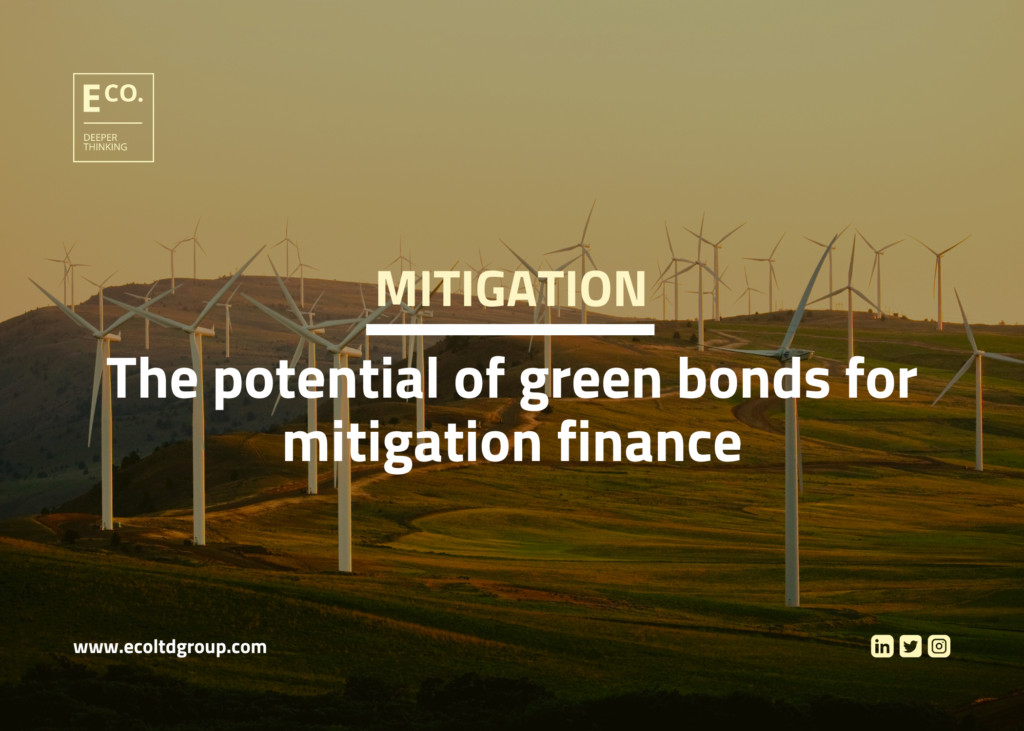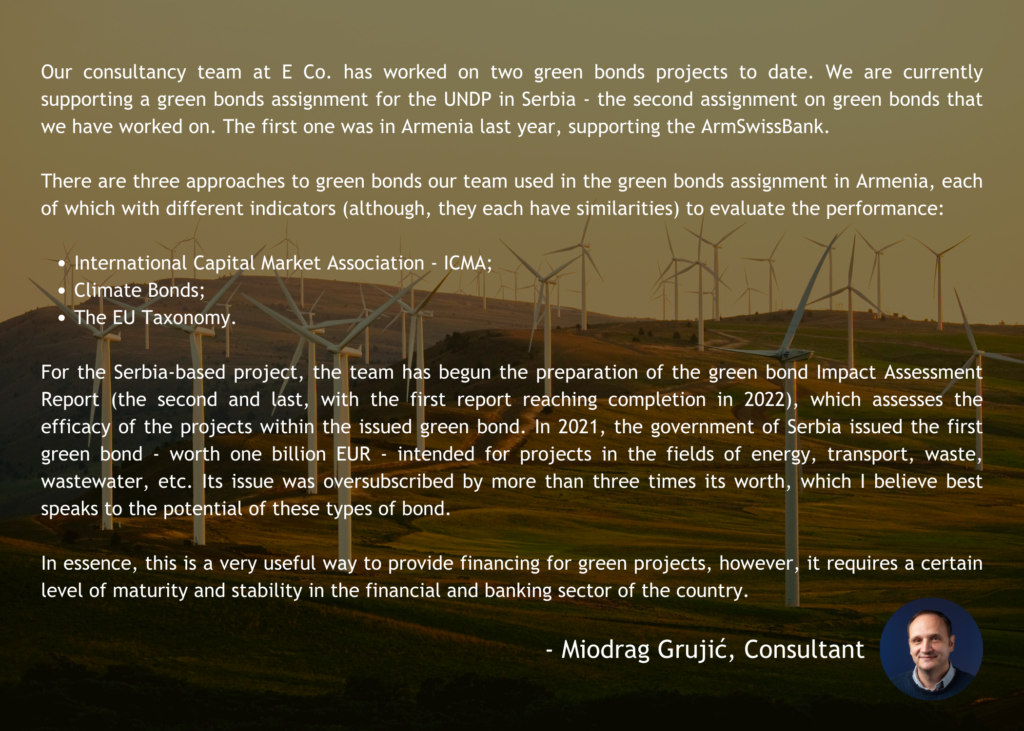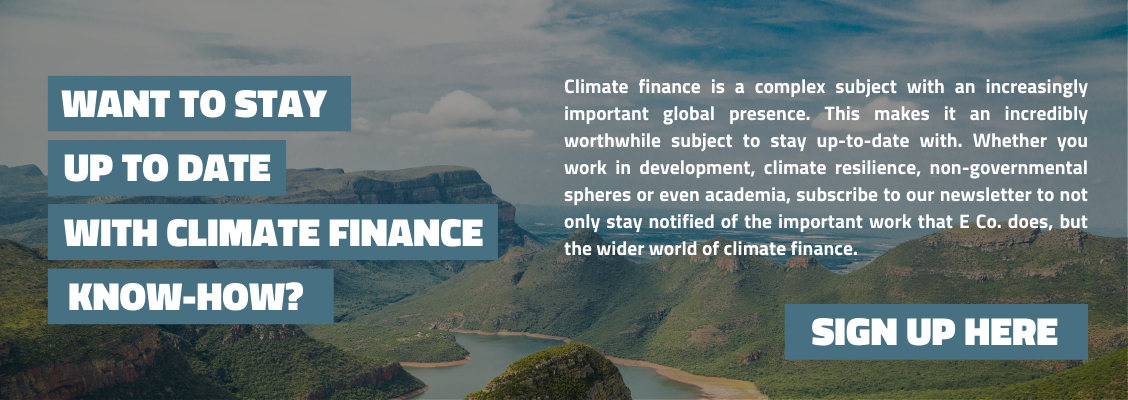The potential of green bonds for mitigation finance
15 August 2023, Category: All insights, News, Tags: climate change, climate finance, green bonds, mitigation, sustainable development

In 2007, the first ever green bond was issued by the European Investment Bank (EIB), at a value of USD 807.2 million. Since then, the market for green bonds has grown in size, hitting USD 1 trillion in December 2020.
The purpose of green bonds is to support climate and environment-related projects, cultivating sustainable development, climate resilience, and emissions mitigation within the projects they finance. They’ve quickly become a critical financial instrument used to bridge the investment gap between what is needed to meet climate targets and what is currently available.
When it comes to mitigation efforts, green bonds have a lot of potential. However, the green bond market is not a space for plain sailing. The market itself suffers from issues of greenwashing, transparency and metric reporting, and a lack of pricing incentives for investors [1] – among other issues.
In this article, we will be exploring the challenges faced by green bonds and their potential for emissions reductions.
- Green bonds: An explainer
- The challenges for green bond usage
- The potential of green bonds as mitigation measures
Green bonds: An explainer
Climate and other types of environmental projects need finance to get off the ground – this is where green bonds come in. This type of bond is a fixed-income instrument which is essentially a loan made by an investor.
There are several types of green bonds, such as a ‘Use of Proceeds’ bond (for instance, the EIB’s Climate Awareness Bonds), or a Project Bond (such as the ones issued by renewable energy company Invenergy for their Campo Palomas Wind Farm in Uruguay). The World Bank is one of the largest issuers of green bonds today, disbursing USD 14.4 billion between 2008 to 2020, with the funds going towards 111 projects – mainly targeting clean transportation and renewable energy.
Green bonds are not to be confused with climate bonds (however, the terms have sometimes been used interchangeably). While they’re similar and undeniably related, climate bonds are bonds that specifically finance projects aimed at reducing carbon emissions and building resilience to climate change. Green bonds have a wider focus than this but are still aimed at building positive outcomes for the environment.
For investors, green bonds are increasingly attractive. In today’s economic climate, impact-based investing is becoming more and more popular as interests in positive social and environmental benefits become the targets of both growth and development. Bonds do not grant ownership of the project in question, which often means they are less risky for investors, as the value of the money loaned is not affected by either the success or failure of the project or the market in which it exists.
A good example of green bonds being successfully implemented is the World Bank’s Energy Security and Efficiency Enhancement Project in Jamaica. The Jamaican Government borrowed USD 15 million, financed by the International Bank for Reconstruction and Development (IBRD), to:
- Strengthen the ‘regulatory and institutional framework to improve sector performance, increase private investment and transition to cleaner fuels’ [3];
- Develop energy efficiency and renewable energy potential;
- Ensure monitoring and evaluation of the above.
Approved in 2011, the project was a success, resulting in the addition of 623 megawatts of renewable capacity added to the grid, and the development of three wind farms, two solar farms, and one hydroelectric plant [4].

The challenges for green bond usage
There are several challenges that successful green bond implementation faces; all represent severe impacts on the continued use of green bonds as a means to achieve climate resilience.
A lack of standardisation
The first major challenge for ensuring green bonds actually provide environmental support is that we currently have no universal standard for determining whether a bond is a net positive in terms of building climate resilience, mitigating emissions, or improving the environmental status of a project’s target.
Reporting within any environmental work is vital for ensuring a true positive impact. For green bonds, reporting is dependent on two things:
- A pre-issuance disclosure;
- Post-issuance reporting on the actual use of the bond.
While many green bonds utilise the ICMA’s Green Bond Principles, these principles do not state what use of proceeds are considered ‘green’. Current practice leaves this responsibility in the hands of a second opinion reviewer, who reviews a bond upon issuance. Issuers themselves work within their own criteria of what is ‘green’, which leaves a lot of room for interpretation.
Fortunately, in 2019 the EU Commission did publish a report on the EU Green Bond Standard – a document that contains a detailed taxonomy that can be used to describe a bond and how it provides a net-positive environmental impact. However, not everybody uses this standard. In fact, a 2019 study carried out by the Climate Bond Initiative found that only 68% of the bonds analysed within the study included regular post-issuance reporting. Unfortunately, just over half of those bonds included reporting on impact metrics [2].
Greenwashing
As these bonds exist in a market designed to attract investors and ensure a return on investment, it is possible that greenwashing is employed to make these bonds seem more impactful than they actually are.
The previous issue of a lack of standardisation has a detrimental effect here – without an internationally recognised legal framework for ascertaining the positive environmental benefits of the bond in question, it is simple for issuers to describe them as ‘green’ without evidence to back up such a claim. Similarly, green bonds don’t necessarily come with any protective provisions, which can also lead to issues of greenwashing.
Greenwashing or good practice?
One contentious example of a green bond in practice is the case of Madrid-based oil and gas company Repsol. In 2017, Repsol were the first oil and gas company to issue a green bond, which went towards improving the efficiency of their oil refineries through the upgrading of equipment, improving operating criteria, and network optimisation (amongst other things). With the implementation of the bond, Repsol expected an emissions reduction of 1.2 million tonnes of CO2 annually by 2020.
Upon first reading, this sounds like a positive. This move does represent the practical application of greener business practices to produce a lower-emission outcome, and Repsol demonstrated good levels of transparency and data disclosure during the process.
However, consider the legislation and analysis provided by the Paris Agreement and subsequent COP events – global emissions must halve every ten years to meet the goals of the Paris Agreement. This requires a massive re-orientation of business, business models, and growth strategies. The year prior to Repsol’s issuance of their green bond, their CO2 emissions were 19.7 million tonnes of CO2 (not including indirect emissions), so a potential reduction of 6% of emissions is not good enough.
In most cases, Repsol’s green bond issuance is not seen as greenwashing. However, it is a very good example of an oil and gas company not doing enough with respect to what is actually needed. When considering the amount of emissions abatement required to stay within the global 1.5 degree carbon budget, small incremental change is not optimal.
The potential of green bonds as mitigation measures
With the increase in the use of green bonds and the growth of the green bond market, various climate organisations have made headway in the development of standardisation metrics – metrics that help to classify what kind of benefits and impacts a green bond will have upon implementation. For example, in use today there are:
- The European Union’s Green Bond Standard;
- The Cicero Shades of Green program;
- And the Green Bond Principles.
For green bonds to achieve their full potential as mitigation measures, being able to analyse and quantify the impact achieved from a specific green bond project is vital. Not only does this lead to more successful projects and fewer instances of greenwashing, it also provides validation for investors, who see impact-based investing as an attractive opportunity.
Multilateral climate funds are also beginning to see the potential of green bonds. At the 2022 Forum on Financing for Development, then-Executive Director of the Green Climate Fund (GCF), Yannick Glemarec, announced that green bonds have the potential to bridge the SDG finance gap [5].
The key to truly unlocking the potential for green bonds is the development of international standards and reporting mechanisms on green bonds. If this can be achieved, issuers will find their bonds easier to attract investment, provided the bonds in question meet the aforementioned standards. Green bonds may even have the secondary benefit of bringing sustainable issues more to the fore of public consciousness, helping mainstream environmental problems and increasing the chances for them to be solved – such as current issues with mitigation.
Standardisation represents an opportunity for investors – it provides them with increased capacity to target impact over profit, while also making it easier for an investor to back a specific cause and/or project.
Looking for insight into climate finance? Look no further
Get in touch with our climate finance consultants to discuss a project you’re working on and create successful, fit-for-purpose projects, now and in the future. Email us at: amy@ecoltdgroup.com or find us at the following:
Twitter: @ecoltdnews
LinkedIn: E Co.
Instagram: @ecoltdnews
References
- Baker Mckenzie, 2019. Critical challenges facing the green bond market. Available online at <https://www.bakermckenzie.com/-/media/files/insight/publications/2019/09/iflr–green-bonds-(002).pdf?la=en>
- Climate Bonds Initiative, 2019. POST-ISSUANCE REPORTING IN THE GREEN BOND MARKET. Available online at <https://www.climatebonds.net/files/reports/cbi_post-issuance-reporting_rev092019_en_0.pdf.>
- World Bank. Jamaica Energy Security and Efficiency Enhancement Project. Available online at <https://projects.worldbank.org/en/projects-operations/project-detail/P112780>.
- World Bank, 2022. World Bank (IBRD) Green Bonds FY21 Impact Report | Project Tables. Available online at: <https://thedocs.worldbank.org/en/doc/1e29bb23045f3ee645a59a86c3349c73-0340022022/original/Website-FY21-World-Bank-IBRD-Green-Bond-Project-Tables.pdf.>
- Glemarec, Yannick, 2022. Green and climate resilience bonds – Scaling up access to affordable finance in developing countries, notably in LDCs. Available online at <https://www.greenclimate.fund/speech/green-and-climate-resilience-bonds-scaling-access-affordable-finance-developing-countries#main-content>
One Reply
Join the conversation by posting a comment below. You can either use your social account, by clicking on the corresponding icons or simply fill in the form below. All comments are moderated.

[…] Read more here […]